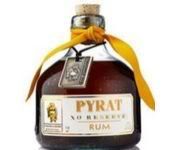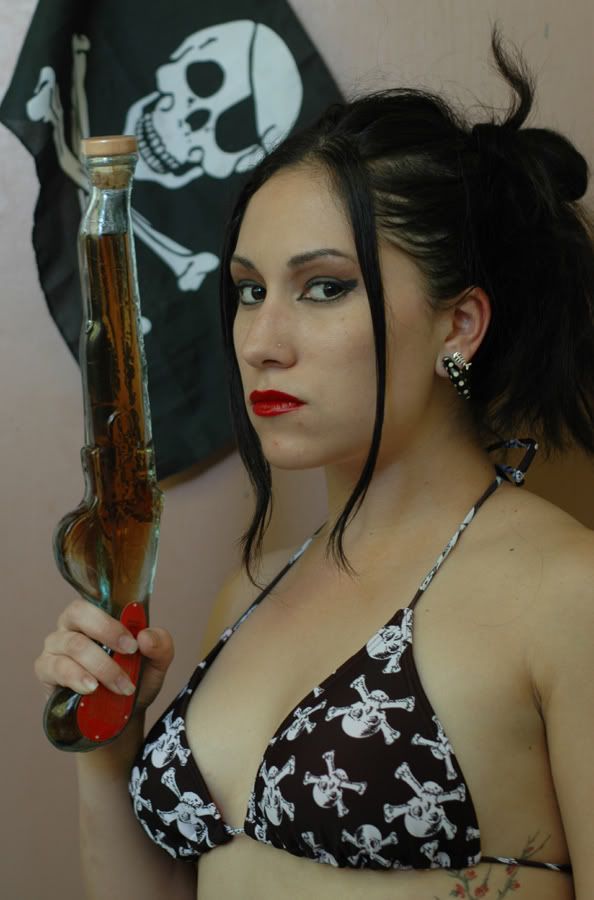-
Posts
850 -
Joined
-
Last visited
Content Type
Profiles
Forums
Events
Gallery
Posts posted by Cascabel
-
-
Depending on the depth of the crack, and where it is, you may get away with using it for a very long time. One of my rifles has a curved crack across the face of the frizzen that has been there for over 30 years of heavy use without a problem. It never progressed to the point of going all the way through. It likely only goes as deep as the case hardening on the surface.
>>>> Cascabel
-
-
This is a push dagger originating in India. It is known as a "Katar". http://en.wikipedia.org/wiki/Katar
>>>> Cascabel
-
A few years back, I was in need of a piece of shark skin to restore a sword handle. I contacted a friend in Florida, and he promissed to send me a piece the next time he caught one.
Anyhow...., he wound up sending me the ENTIRE shark by UPS, frozen solid, of course, with a note saying "skin it yerself !!!". It was as small hammerhead about 3 feet long. I ate the shark, quite tasty, by the way, and used the skin for several projects. Once it is dried, the skin keeps very well.
:angry:
What a great story! (Stories like that are the reason I find re-enacting and re-enactors so much fun.)
......And the rest of the story is that I very carefully removed and cleaned the set of jaws from the shark with the intention of making a pendant or other piece of jewelry out of them. They were perfect miniatures of full sized jaws with multiple rows of teeth. I had propped them open and laid them out in the sun to dry, and one of my cats immediately grabbed them and ran under the porch and ate them !!!
 .......Oh, well.........................
.......Oh, well.........................>>>>> Cascabel
-
I was planning on frosting some empty bottles of the aptly named Pyrat Rum as well. But my poor rhum soaked brain was under the impression that the bottle I was thinking of had more of a neck? I suppose the only thing to do is buy more rhum and watch POTC 3 again.

Speaking of pistol bottles


Huh ??????, you mean there was a bottle in that picture ????, somehow I missed seeing it !!!

>>>> Cascabel
-
It skins fairly easily. You don't need to try to skin the fin areas, just the fairly flat areas like the sides. Just cut out what you want, and start one edge carefully, and pull it off. The belly is good if you want white skin, but it tends to be thinner. After you get it off, rinse in clean water, and stretch it out on a board to dry. It is fairly thin, but tough. Hold it to the board with clothes pins while drying. If you use tacks, they will rust. Salting it heavily on the flesh side will help to draw out the moisture and preserve it. I have not found it necessary to use a tanning process, as it won't be used for anything flexible (at least by me). When it is completely dry, knock off the excess salt.
When you are ready to use it, cut a piece a bit oversize for your project, and soak it in clean water to soften it. Mostly, you will be using it as a glued-on surface layer over something more ridged, or as a decorative covering. It is used commonly on sword handles to give a non-slip grip, and create an attractive look, plus as a decorative textured surface on things like small containers. Various types of ray also have skin with interesting textures.
>>>> Cascabel
-
my question is the shark skin. is there a modern equivalent?
......And why not the real thing ???? They DO still make sharks, ya know !!!

Shark skin is fairly easy to work with. A few years back, I was in need of a piece of shark skin to restore a sword handle. I contacted a friend in Florida, and he promissed to send me a piece the next time he caught one.
Anyhow...., he wound up sending me the ENTIRE shark by UPS, frozen solid, of course, with a note saying "skin it yerself !!!". It was as small hammerhead about 3 feet long. I ate the shark, quite tasty, by the way, and used the skin for several projects. Once it is dried, the skin keeps very well.
>>>> Cascabel
-
Ahoy, HarborMaster.....
Sorry to see you laid up, lad. Whatever your misfortune is, I wish ye a speedy recovery. Fair winds to ye.....
>>>> Cascabel
-
Ahh, I can just 'bout taste the black powder upon me lips!!
...hey, I thinks 'ol Blackbeard may have been on'ta somthin'!

Well, you DO know that the chief ingredient in black powder is saltpeter, also known as "softpeter", right ????



>>>> Cascabel
-
I found this most interesting website for dating Singer sewing machines. http://www.sew2go.com/singerdate.htm
According to this chart, my 42-5 Singer was made between 1941 and 1944. That would explain the more modern V-belt drive on it.
>>>>> Cascabel
-
Another machine that I have that works well for heavy sewing is the Singer model 29-4. It is also an early machine, but more commonly available on ebay than the 42-5. It is designed to reach inside a sleeve, pocket, or down inside of a boot or shoe. It is also very suitable for flat sewing with the accessory table (which is easy to make, if not included). There were also similar machines made by Durkopp and Adler
These remained in production for a long time, with more recent models designated 29k4, and 29k70. Any of the Singer model 29 series of machines are very similar. There are modern made copies available also. I think Singer ceased production on the model 29's some time ago, but they are used in the shoe repair business even today. The only drawback to these machines is that the bobbin is small.
>>>>> Cascabel
-
A word of caution about buying sewing machines. Many times on ebay, and other places, machines are advertised as industrial "strength". Usually they are NOT true industrial machines.
Just because they are old, and painted black does not make them industrial machines. Most of the ones advertised as "industrial strength" machines are just old houshold machines. Perfectly good machines, but definitely NOT industrial machines, with industrial capability and power.
A true industrial machine is very much larger, heavier, and more powerful. The easiest way to tell is if the motor is small and attached to the back of the machine, it is a common household machine. Industrial machines use a large motor, (about as big as your head), mounted underneath the table.
>>>>> Cascabel
-
This is an excellent source of information for older machines. There are also user manuals available in pdf format for many older Singer machines. These are great for threading instructions, etc.
There is a surprising availability of spare parts for these old machines from Singer, and obsolete sewing machine parts suppliers. Don't ever reject buying an old industrial Singer for fear of not being able to get parts. These things are like the Energizer Bunny, they keep going, and going, and going......
>>>>> Cascabel
-
Nice !!! That particular one is much earlier than the one I have. It uses a round leather belt. Otherwise it is identical to mine, except for the table.
Mine incorporates a modern type "V" belt on the flywheel, as does another of my aquaintance. I don't know when "V" belts became common, but the flywheel with "V" belt groove is original to my machine. And the table is much more modern. The one I found on ebay recently uses the earlier round belt style of pulley. Because of its great utility, I suspect it enjoyed a very long production run.
If you find out the actual years of production, please enlighten us. I never got a reply from Singer regarding this.
>>>> Cascabel
-
Yes, indeed, it is a discontinued model....
I'm not 100% sure of production years of the model 42-5, but they probably started production in the 1930's, and probably ceased production in the late 1950's to early 1960's, judging by the appearance of examples I have seen. If properly maintained, these machines will last several lifetimes. Parts and spare bobbins are still readily available from Singer. For pics, here is the one I recently got on ebay : http://cgi.ebay.com/ws/eBayISAPI.dll?ViewI...:MEWN:IT&ih=019
>>>>> Cascabel
-
I highly reccommend the Singer Model 42-5. I have one of them, and it will easily handle 1/2" of heavy belt type leather, plus any canvas work I have ever asked of it. It has a walking foot, and a large flywheel, which allows it to run slowly if needed, and still have plenty of "grunt" to drive the needle through any material. I truly believe that it could sew quarter inch plywood if I wanted to try it !!! It will also do nicely with lighter weight fabrics with a change of needles. It does not have zig-zag capability, but I have never found the need for it.
They can sometimes be found on ebay. I recently stumbled upon one on ebay that I secured for a friend for $150. If you are considering an industrial machine, I think one of the most important features for our purposes is the ability to run slow, which gives you the opportunity to manipulate your project easily while working. These 42-5 machines will also run faster than you can keep up with, if you want, so I find them ideal.
Many industrial machines that become available on the used market are high speed manufacturing machines, and really unsuitable for what most of us do.
>>>>> Cascabel
-
I don't blame the people of Somalia.
..... So who would you blame ? Norwegians ?


-
Blue, black, and brown finishes all existed in the period. Also, black paint over all, including metal parts was sometimes used for shipboard weapons for protection against rust.
You have to be careful when forming an opinion from examining period examples, as natural darkening of unfinished steel parts that were originally polished bright can be mistaken for a deliberately applied brown finish. Originally blued finishes can also turn to a brown color with age, depending on handling and storage conditions. The blueing process is actually a controlled rusting, which with the proper chemicals becomes various shades of blue or black, depending on the process used.
>>>> Cascabel
-
Nicely done, sez I !!!!! That is one of my favorite PBS productions. I'm glad it finally became available on DVD.
>>>>> Cascabel
-
I'm on board !!!
>>>> Cascabel
-
Cascable,
True, you're coming up for the L.I. Pirate Festival?
Aye, Shipmate. I'll be thar. Lookin' forward to seein' ye again....
>>>> Cascabel
-
If you are going to build a carriage, it must be kept in mind during the planning stages that the "steps" in the carriage need to be located properly. They are not for decorative purposes.
They are located where the bolts that hold the rear axle in place need to seat, and where they can act as fulcrum points for using handspikes for lifting the barrel to adjust elevation. The locations can vary a bit depending on barrel configuration, as you need to be able to get the ends of the handspikes under the barrel in order to lift it. On a full size cannon, this is an important issue because of the weight. On a large carriage, additional re-inforcing bolts also will need a spot to seat. Most original carriages I have seen use bolts that go all the way through from top to bottom. The trunnion caps are held by full length bolts with the upper ends made to accomodate the caps. The front axle is usually secured by these bolts. No matter which "period" design you choose, it needs to consider the strength needed to stand the recoil forces.
>>>> Cascabel
-
I feel better already not being the only Pirate with a hat the size of Rhode Island!

I think a lot of us would wear big hats if we could find 'em !!!
"He must be the captain. He's got the biggest hat !!"

>>>> Cascabel
-
Nicely done, sez I....
I have an old original that looks about like that.
>>>>> Cascabel



Pistols and accessories
in Armory
Posted
This type of lock is known as a Miquelet.
http://en.wikipedia.org/wiki/Miquelet
These are common on Spanish made guns, and also well known on Italian pieces. They are seen on Arabic weapons too. Most all I have seen are on guns from the Mediterranean area, and some Balkan pieces.
The chief advantage with the mainspring and most of the works on the outside is that it makes for a much stronger stock. The amount of wood cut away to clear the mainspring and workings of a conventional lock weakens the stock considerably in the lock area. I have seen a great many antique guns with the stock broken through the lock area.
The Spanish military swore by this design even up into the early percussion era. There is also quite a bit less work involved in inletting the stock to receive this type of lock. Disadvantages are that the moving parts are exposed to dirt and damage .
>>>> Cascabel